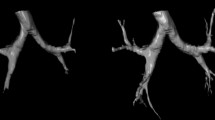Abstract
Purpose
We present a systematic approach for studying positron emission tomography–computed tomography (PET/CT) 3-D virtual fly-through endoscopy and for assessing the accuracy of this technology for visualizing and detecting endobronchial lesions as a function of focal lesion morphology and activity.
Procedures
Capsules designed to simulate endobronchial lesions were filled with activity and introduced into a porcine lung–heart phantom. PET/CT images were acquired, reconstructed, and volume rendered as 3-D fly-through and fly-around visualizations. Anatomical positioning of lesions seen on the 3-D-volume-rendered PET/CT images was compared to the actual position of the capsules.
Results
Lesion size was observed to be highly sensitive to PET threshold parameter settings and careful opacity and color transfer function parameter assignment.
Conclusion
We have demonstrated a phantom model for studies of PET/CT 3-D virtual fly-through bronchoscopy and have applied this model for understanding the effect of PET thresholding on the visualization and detection of lesions.







Similar content being viewed by others
References
Ueno J, Murase T, Yoneda K, Tsujikawa T, Sakiyama S, Kondoh K (2004) Three-dimensional imaging of thoracic diseases with multi-detector row CT. J Med Invest 51:163–170
Ferguson JS, McLennan G (2005) Virtual bronchoscopy. Proc Am Thorac Soc 2:488–491 504–505
De Wever W, Bogaert J, Verschakelen JA (2005) Virtual bronchoscopy: accuracy and usefulness—an overview. Semin Ultrasound CT MR 26:364–373
Ell PJ (2006) The contribution of PET/CT to improved patient management. Br J Radiol 79:32–36
Bruzzi JF, Munden RF (2006) PET/CT imaging of lung cancer. J Thorac Imaging 21:123–136
Veit-Haibach P, Kuehle CA, Beyer T et al (2006) Diagnostic accuracy of colorectal cancer staging with whole-body PET/CT colonography. Jama 296:2590–2600
Quon A, Napel S, Beaulieu CF, Gambhir SS (2006) “Flying through” and “flying around” a PET/CT scan: pilot study and development of 3D integrated 18F-FDG PET/CT for virtual bronchoscopy and colonoscopy. J Nucl Med 47:1081–1087
Seemann MD, Schaefer JF, Englmeier KH (2007) Virtual positron emission tomography/computed tomography-bronchoscopy: possibilities, advantages and limitations of clinical application. Eur Radiol 17:709–715
Yoon SHR, Bouley D, Fahrig R (2006) Characterization of a novel anthropomorphic plastinated lung phantom. AAPM 48th Annual Meeting. Orlando, FL
Wang Y, Chiu E, Rosenberg J, Gambhir SS (2007) Standardized uptake value atlas: characterization of physiological 2-deoxy-2-[(18)F]fluoro-d-glucose uptake in normal tissues. Mol Imaging Biol 9:83–90
Doshi NK, Basic M, Cherry SR (1998) Evaluation of the detectability of breast cancer lesions using a modified anthropomorphic phantom. J Nucl Med 39:1951–1957
Galofre M, Payne WS, Woolner LB, Clagett OT, Gage RP (1964) Pathologic classification and surgical treatment of bronchogenic carcinoma. Surg Gynecol Obstet 119:51–61
Harpole DH Jr, Feldman JM, Buchanan S, Young WG, Wolfe WG (1992) Bronchial carcinoid tumors: a retrospective analysis of 126 patients. Ann Thorac Surg 54:50–54 discussion 54–55
Luomanen RKJ (1968) W.W. A study of five thousand Memorial Hospital cases. Mosby, St Louis, MO
Acknowledgments
Thanks to the following individuals from Stanford University: Laura Pierce and Mark Sofilos for helping with visualization software, Christine Fujii and Luan Nguyen help with using the PET/CT scanner, Amelie Lutz and Juergen Willmann for help with making CT measurements of capsule dimensions, and Jarrett Rosenberg for assistance with statistics. This work is supported in part by NCI ICMIC P50 CA114747 (SSG) and the Canary Foundation.
Author information
Authors and Affiliations
Corresponding author
Electronic Supplementary Material
Below is the link to the electronic supplementary material.
Supplementary Video 1a
PET-CT 3D fly-around rendering for study 1. Rendering were created using GE Volume Viewer software on the advanced workstation. Background PET activity and low density structures in CT data were first thresholded. PET and CT axial images were independently volume-rendered. CT information was colored in grayscale, whereas PET activity was colored in red. The volume-rendered images were fused to create a single fusion 3D rendering. CT opacity was set to <20 HU. Visualization of images from study 1 contains three lesions, one in the trachea and two in the right main stem bronchus. (A) (MOV 230 KB)
Supplementary Video 1b
PET-CT fly-around rendering for study 2 containing two lesions, one at the carina and one in the right main stem bronchus. (MOV 229 KB)
Supplementary Video 2
PET-CT 3D Virtual fly-through bronchoscopy movie. PET and CT images were fused and rendered based on the data processing scheme detailed in Fig. 2. PET lesions are rendered in white and CT anatomical information delineating the lumen wall is rendered in orange. (MOV 1.27 KB)
Supplementary Video 3a
Raw axial PET-CT image data. These images show axial PET-CT data where CT is represented in grayscale and PET radiotracer activity is superimposed in color. These axial images were used as the basis for generating fly-around and fly-through renderings. Two datasets were acquired including study 1 (A) and study 2 (B). (A) (MOV 417 KB)
Supplementary Video 3b
(MOV 786 KB)
Supplementary Video 4a
(MOV 599 KB)
Supplementary Video 4b
(MOV 160 KB)
Rights and permissions
About this article
Cite this article
Yerushalmi, D., Mullick, R., Quon, A. et al. Simulations of Virtual PET/CT 3-D Bronchoscopy Imaging Using a Physical Porcine Lung–Heart Phantom. Mol Imaging Biol 11, 275–282 (2009). https://doi.org/10.1007/s11307-009-0201-8
Received:
Revised:
Accepted:
Published:
Issue Date:
DOI: https://doi.org/10.1007/s11307-009-0201-8




